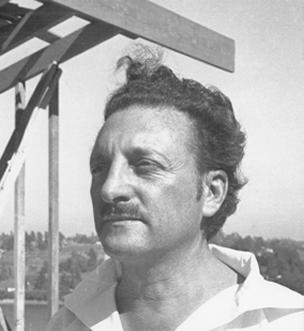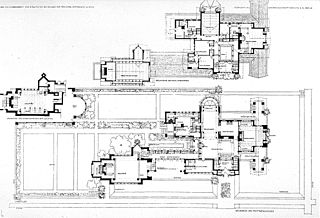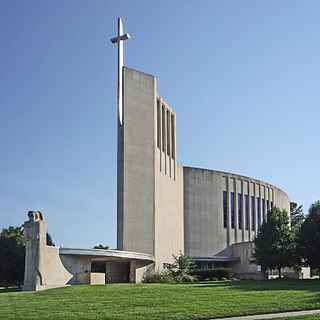Construction
Wright's drawings of the bank and hotel are dated from as early as December 17, 1908. Construction began on April 1, 1909, with supervision by Wright until his departure for Europe in late October of that year. At that time, architect William Drummond, from Wright's Oak Park Studio in Oak Park, Illinois, took over supervision of the construction. During his subsequent visits, Drummond was commissioned to design a Prairie style home for a prominent Mason City family, not far away.
The law office of developer-owners Blythe and Markley opened for business on August 29, 1910, with the gala opening of the new hotel and bank buildings, two weeks later, on September 10. A month later, Wright returned to the Midwest from his year in Europe.
Despite its glossy, up-to-date appeal and choice location, just west of Mason City's primary downtown intersection of Federal Avenue and State Street, overlooking Central Park from the south, the Park Inn Hotel struggled through a relatively short life. The building had simply cost too much, and the return on investment was simply too little. During its first ten years, the hotel seldom made a profit. By 1922, the business was barely afloat, and the restaurant was closed more than it was open. Then, just when things could hardly get worse, disaster struck.
Nearby, overlooking Central Park from the west, the regal, stylish, 250-room Hotel Eadmar was newly-completed, and now open for business. The 250-room Eadmar, four massive stories of Edwardian elegance and comfort, made a powerful statement. On the other hand, with just 43 rooms, the Park Inn had very little to say. No longer stylish, now regarded as strictly second-class, the Park Inn couldn't compete. It soon went bankrupt, and closed for good in 1925.
Adding insult to injury, 1925 also saw the closure and liquidation of the City National Bank. It was quickly absorbed by another local bank, which, just a few months later, would itself fail. The nationwide farming crisis had, for Mason City, led to a banking crisis as well. By the end of 1925, four of the city's five banks had failed.
By early 1926, the worst seemed to be over. That year, the former City National Bank building and the former Park Inn Hotel, were sold, but as separate properties. The old bank building underwent an extensive, quite unsympathetic remodeling, then reopened as a new commercial venture in 1928. As for the Park Inn, the two upper floors were clumsily converted into small, cheap apartments. No longer a hotel, the building was renamed. in honor of its world-renown architect, becoming the Frank Lloyd Wright Apartments East and West.
For the next 45 years, the once-charming Park Inn would be anything but charming. The ground floor had hosted a multitude of different businesses - for a brief period, in the early 1970's, it had even been a strip club - and the two floors above were now cramped, dreary, just-getting-by apartments, the renters who chose them couldn't afford to be choosy. The building, in decline for years, now began to deteriorate. Finally, in 1972, the few remaining tenants were served notice, then were sent packing.
For the next 25 years, the building stood empty. Derelict and neglected, city residents and city leaders fretted, fussed, fumed, and fought about what to do with the dingy, shabby, all-too-conspicuous eyesore. Even the cachet of the architect's name meant little or nothing. In Mason City, most people didn't really know who Frank Lloyd Wright was, and those who did know didn't really care. Almost everyone knew, and most agreed, that the building wasn't really worth saving.
What almost no one knew, however, was that the Park Inn had been the only remaining hotel in the world designed by Frank Lloyd Wright, who, even years after his death, retained almost a legendary status as an architect. What's more, Wright had designed only six hotels to begin with - and five had long since been demolished. Now, the wrecking ball appeared to be taking aim at Number Six. Only then did Mason City realize what they had on their hands - and how very close they were, even then, to not having it at all.
Suddenly, seemingly overnight, Mason City had an architecturally, culturally, and historically significant treasure on their hands. But what they didn't have on their hands was much money, or much time. This realization became something of a call to arms. The people had to take action, to find the money, then to take the time to restore the Park Inn to its former glory. If they didn't, it would soon be out of their hands.

Frank Lloyd Wright was an American architect, designer, writer, and educator. He designed more than 1,000 structures over a creative period of 70 years. Wright played a key role in the architectural movements of the twentieth century, influencing architects worldwide through his works and hundreds of apprentices in his Taliesin Fellowship. Wright believed in designing in harmony with humanity and the environment, a philosophy he called organic architecture. This philosophy was exemplified in Fallingwater (1935), which has been called "the best all-time work of American architecture".

Walter Burley Griffin was an American architect and landscape architect. He designed Canberra, Australia's capital city, the New South Wales towns of Griffith and Leeton, and the Sydney suburb of Castlecrag.

Mason City is a city and the county seat of Cerro Gordo County, Iowa, United States. The population was 27,338 in the 2020 census, a decline from 29,172 in the 2000 census. The Mason City Micropolitan Statistical Area includes all of Cerro Gordo and Worth counties. It is commonly referred to as the "River City", as the city grew up centered on the Winnebago River.

Richardsonian Romanesque is a style of Romanesque Revival architecture named after the American architect Henry Hobson Richardson (1838–1886). The revival style incorporates 11th and 12th century southern French, Spanish, and Italian Romanesque characteristics. Richardson first used elements of the style in his Richardson Olmsted Complex in Buffalo, New York, designed in 1870. Multiple architects followed in this style in the late 19th century; Richardsonian Romanesque later influenced modern styles of architecture as well.

The Price Tower is a nineteen-story, 221-foot-high tower at 510 South Dewey Avenue in Bartlesville, Oklahoma. It was built in 1956 to a design by Frank Lloyd Wright. It is the only realized skyscraper by Wright, and is one of only two vertically oriented Wright structures extant; the other is the S.C. Johnson Wax Research Tower in Racine, Wisconsin.

Rudolph Michael Schindler was an Austrian-born American architect whose most important works were built in or near Los Angeles during the early to mid-twentieth century.

The Wasmuth Portfolio (1910) is a two-volume folio of 100 lithographs of the work of the American architect Frank Lloyd Wright (1867–1959).

Prairie School is a late 19th- and early 20th-century architectural style, most common in the Midwestern United States. The style is usually marked by horizontal lines, flat or hipped roofs with broad overhanging eaves, windows grouped in horizontal bands, integration with the landscape, solid construction, craftsmanship, and discipline in the use of ornament. Horizontal lines were thought to evoke and relate to the wide, flat, treeless expanses of America's native prairie landscape.

Crystal Heights was a design by American architect Frank Lloyd Wright for a hotel, apartment, and shopping complex in Washington, D.C. The project would have been built on one of the largest remaining undeveloped tracts in the city, known as the Oak Lawn estate or Temple Heights, on the edge of the Adams Morgan and Dupont Circle neighborhoods. The site was bounded by 19th Street, Columbia Road, Connecticut Avenue, and Florida Avenue, all in the northwest quadrant.

Francis Barry Byrne was a member of the group of architects known as the Prairie School. After the demise of the Prairie School, about 1914 to 1916, Byrne continued as a successful architect by developing his own style.

Isabel Roberts House is a 1908 Prairie Style house by architect Frank Lloyd Wright, located at 603 Edgewood Place in River Forest, Illinois It was built for Isabel Roberts and her widowed mother, Mary Roberts.
Isabel Roberts was a Prairie School figure, member of the architectural design team in the Oak Park Studio of Frank Lloyd Wright and partner with Ida Annah Ryan in the Orlando, Florida architecture firm, "Ryan and Roberts".
William Eugene Drummond was a Chicago Prairie School architect.
George Rodney Willis, was an American architect associated with the Prairie School and the Oak Park, Illinois studio of Frank Lloyd Wright who thereafter had a successful career in California and in Texas.

The Eugene A. Gilmore House, also known as "Airplane" House, constructed in Madison, Wisconsin in 1908, is considered "a superb expression of Frank Lloyd Wright's mature Prairie school." The client, Eugene Allen Gilmore, served as a law professor at the nearby University of Wisconsin Law School. In 1973 the house was added to the National Register of Historic Places.

The Dr. G.C. Stockman House was designed by Frank Lloyd Wright and built in 1908 for Dr. George C. and Eleanor Stockman in Mason City, Iowa. The home was originally located at 311 1st St. SE, but was moved to 530 1st St. NE to avoid demolition. It has been fully restored as a public museum and is listed on the National Register of Historic Places. It features numerous authentic period furnishings and reproduction pieces.
The Last Wright is an American documentary film released in 2008. It focuses on the only surviving hotel designed by Frank Lloyd Wright. It was produced by Travelfilm Company and McMar, Ltd/28 and was produced and written by Garry McGee and Lucille Carra and directed by Lucille Carra. Researched and filmed over a seven-year period, the film is the only video record of the distressed condition of the hotel. The film explores the history of the Mason City Bank and Hotel Commission (1908) as well as the struggles of the rural city of Mason City, Iowa to restore the Park Inn Hotel, which, along with the City National Bank, was a rare example of a Prairie School style mixed-use structure by Wright.

The Curtis Yelland House is a historic building located in Mason City, Iowa, United States. Frank Lloyd Wright associate William Drummond designed this Prairie School style house, completed in 1910. The house features a strong horizontal emphasis, broad hip roofs, board-and-batten siding, stucco on the upper-story, and a centrally located fireplace and chimney round which the open plan interior revolves. The main entry is on the side of the house. The only entry to the front porch is from the living room. It was listed on the National Register of Historic Places in 1980. The house suffered a devastating fire in 2008, and was almost torn down. However, developer Jeff Tierney bought the property and restored the house in 2010.

The Mason City Downtown Historic District is a nationally recognized historic district located in Mason City, Iowa, United States. It was listed on the National Register of Historic Places in 2005. At the time of its nomination it contained 93 resources, which included 63 contributing buildings, one contributing site, four objects, 22 non-contributing buildings, and three non-contributing objects. Platted in 1855, Mason City is a commercial and industrial center for north central Iowa. It was also a railroad center, but the tracks bypassed the central business district in order to serve the industries located on the north side of town and the wholesale enterprises on the south side. Central Park, a public square, was part of the city's original plat and is the contributing site.

"A Fireproof House for $5000" is an article and house design by Frank Lloyd Wright published in the Ladies' Home Journal in April 1907. It is Wright's third and final publication in the journal following "A Home in a Prairie Town" and "A Small House with 'Lots of Room in It'" from February and July 1901, respectively. The drawings for the house were also included in Wright's 1910 Wasmuth Portfolio (Plate XIV).

























